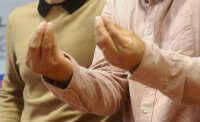“We can’t return, we can only look behind.”
– Joni Mitchell
Despite the persistence and power of memory, the seduction of the past and 20/20 hindsight, the arrow of time appears to go in one direction only: forward. It might be more accurate to say “outward,” insofar as forward inclines one to think of the Euclidian straight-line trajectory a point follows in space, like a cue ball sent across a billiard table. Time is more of a radiative phenomenon, continuously emanating simultaneously and infinitely from everything in all directions to all points everywhere, except that is, the past. As Joni Mitchell reminds us, we can’t literally turn back the clock.
In mathematical models, time running backwards presents no obstacle, and in fact is used to test the validity of formulaic hypotheses. Mathematics provides a remarkable and even uncannily accurate description of the workings of the universe, but its imaginary numbers, time running backwards, multiple dimensions and quantum effects are often paradoxical and defy conventional logic. Mathematics may well contain the secrets of existence, but in its most sophisticated forms it’s character is purely metaphysical and largely beyond physical demonstration.
However, the ease with which mathematical models create conceptual possibilities makes the idea of time travel appealing. Going backwards to change events in the past creates problems, however, specifically due to the arrow of time. As each event transpires, the probability of differing events happening instead collapses, and the arrow of time carries the final event information into a new set of probabilities. These waves of probability emanating at each event instantaneously and non-obstructively intersect with each other, creating infinite complexity. The arrow of time carries inconceivable amounts of information into the present moment; thus what we experience as the arrow of time is actually this complex combination of carried information and the outcome of probability collapse.
Reality appears to us to be composed of individual objects and moments. Our culture supports this view with the use of named objects and social dependence upon “clock” time. Named objects make sense at human scale, but quickly lose meaning at the micro or macro level. When we move to the micro, every object ultimately dissolves into a changing dynamic of fields, forces and what we call “elementary particles.” In this sense, all conventional objects share in the equality of being empty of any specific fixed nature. When we move to the macro, conventional objects quickly recede in scale to an ultimately indistinguishable element of background information; the sun and our solar system become just one of uncountable trillions of such systems in an infinite universe.
“Clock” time also seems real, but minutes, seconds and milliseconds are arbitrary segments in an otherwise indivisible continuity of radiance. The arrow of time is radiating constantly, and periodicity is not one of its inherent characteristics. Clock time is an imposed social convention implemented alongside the mechanical clock in the 1800’s. Even the most sophisticated “atomic” clocks eventually need correction. Time’s arrow is unbroken, unbreakable, indivisible, and inseparable; it’s what makes “now” possible.
Radiating like an ever-rising sun, unfolding and opening like an eternally blossoming flower, the arrow of time can be felt but cannot be halted or reversed, except in memory and mathematics. Thus it is all and everything, each and every one of us, are so quivered.







Be First to Comment